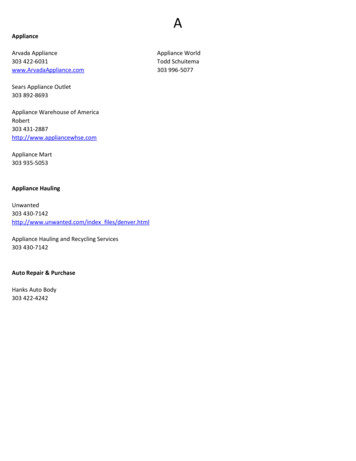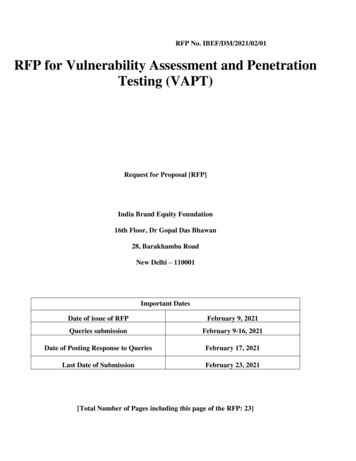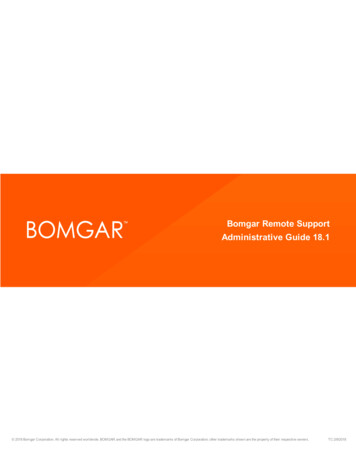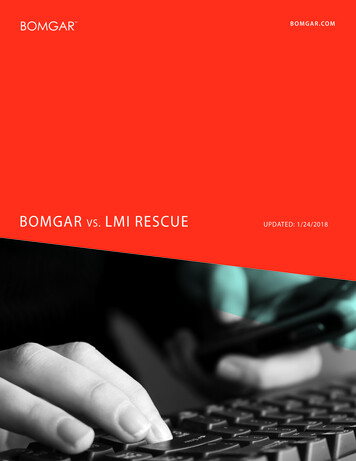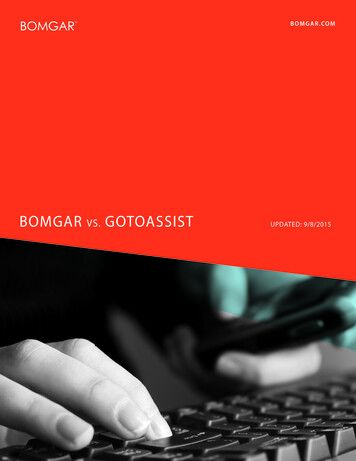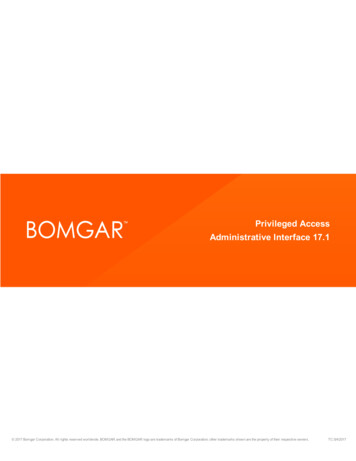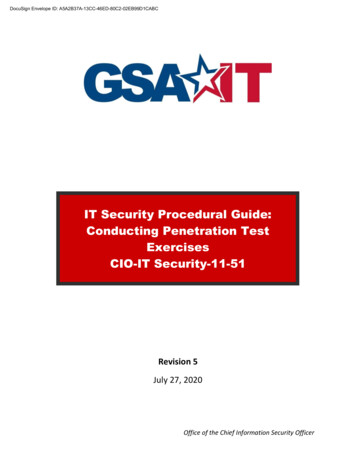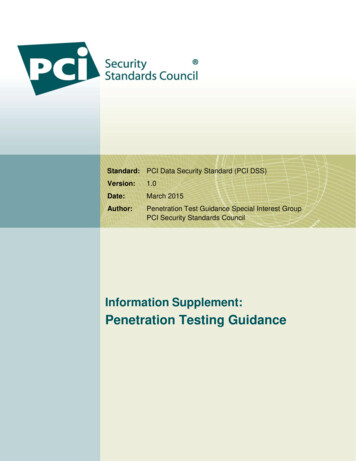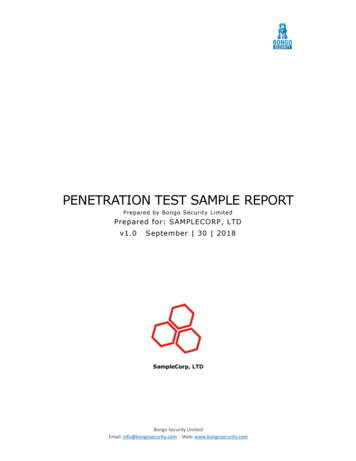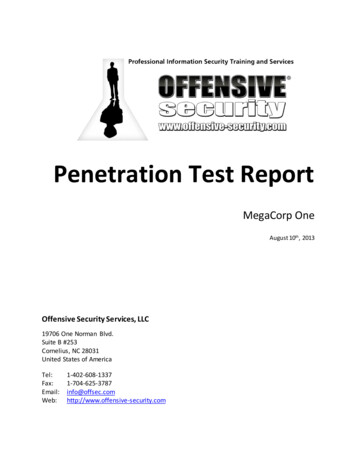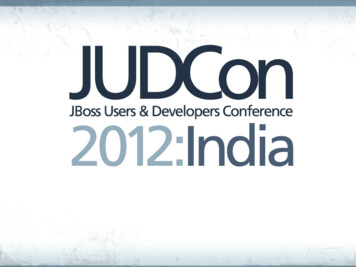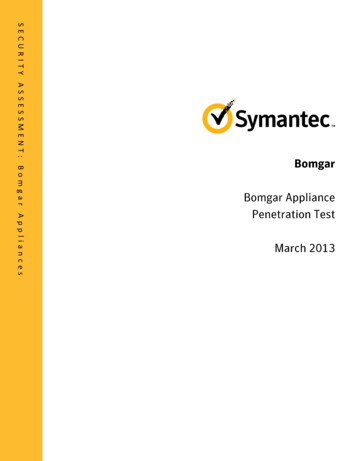
Transcription
SECURITY ASSESSMENT: Bomgar Appliances
Security Assessment: Bomgar Appliance Penetration TestMarch 2013During the period between November 2012 and March 2013, Symantec Consulting Services partnered with Bomgar toassess the security architecture and implementation of the Bomgar appliances. During the engagement, Symantecperformed a Product Penetration Test to evaluate the application components and related environment againstestablished security best practices.A Product Penetration Test is designed to provide insight into methods of attack against a specific product or suite ofapplications and present a reasonable example of what an attacker might accomplish. The assessment concentrates onmodeling specific attack scenarios, identifying vulnerabilities, and validating exploitation possibilities. The findingspresented in this document are accurate as of the time of writing and are the opinion of Symantec; as both products andsecurity technologies evolve, these statements may or may not be applicable to future releases and Symantec does notguarantee future accuracy of these statements.Symantec conducted the Product Penetration Test to evaluate the security architecture of the Bomgar appliance andsupporting components in order to identify security vulnerabilities that might pose risk to Bomgar’s customers. Thepurpose of this test was to ascertain the security posture of the targeted product from a hacker’s or a malicious user’sperspective and determine what, if any, resources could be compromised through attacks on confidentiality, integrity, oravailability.During the assessment, Symantec found the overall architecture of the Bomgar appliances to be designed andimplemented with security best practices in mind. Although initial testing was performed on Bomgar B200, B300, andB400 appliances running version 12.3 software, the findings in this document should pertain to any Bomgar Boxappliance running firmware version 3.3 and 3.4 with the latest maintenance releases as of April 2013 applied.The Bomgar environment consists of the following key components: Bomgar Appliance: The Bomgar appliance is a dedicated hardware box that supports Bomgar’s base servercomponents and administrative interfaces and acts as a centralized routing interface for all communicationbetween support agents and end users. Bomgar Representative Console: The Bomgar Representative Console is a multi-platform application used bysupport desk agents to remotely access customer workstations and perform chat, file transfer, and remotemanagement operations. Bomgar Customer Client: The customer client is a cross-platform executable that is downloaded duringinitiation of a support session and enables the support representative to gain remote access to the customer’sworkstation. Upon termination of the session, the program automatically uninstalls or can remain on the user’sPage 1
Security Assessment: Bomgar Appliance Penetration TestMarch 2013workstation to support long running issues.The scope of the assessment included the following Bomgar components and client operating systems: Bomgar Software: 12.3 - /login Bomgar Firmware: 3.3 - /appliance Bomgar Firmware: 3.4 - /appliance Bomgar Jumpoints Bomgar Jumpoints/vPro Bomgar Rep Console – Windows, Mac, Linux, iPhone, iPad, Android Phone, Android Tablet Bomgar Smart Card Support Bomgar Rep Invite Bomgar Customer Client – Windows, Mac, Linux, Blackberry, Windows Mobile, iPhone, iPad, Android Phone andAndroid Tablet Bomgar Jump Clients Bomgar Passive Jump Clients Bomgar Button Bomgar Connection Agent Bomgar Integration ClientDuring the assessment, Symantec reviewed the various Bomgar components and their interactions and how the completesolution worked to defend against attackers.The tenants of security are the result of a secure foundation at the hardware layer.The Bomgar appliances are shipped as self contained, hardened servers that utilize a minimal base firmware to helpcustomers install the Bomgar solution. The servers have been hardened from both a software and physical level. The onlyaccess allowed to the device is through a private link local IP address preconfigured on the network interface adapters onthe server. All USB ports are disabled through the BIOS and cannot be used for keyboards or mounting USB drives. Thefirst step for installing the Bomgar solution is to update the base firmware to the latest version. Once this is in place anSSL certificate can either be imported or a certificate signing request can be generated through the firmware UI. With thebase firmware updated, the latest Bomgar application can be downloaded and installed onto the appliance.Symantec conducted port scans of the Bomgar appliance and found that four network ports were enabled in the defaultconfiguration. A review of the ports enabled on the Bomgar appliance revealed that three of the ports were forconnectivity to HTTP (TCP 80), HTTPS (TCP 443) and an alternative HTTPS port (TCP 8200). The fourth port was for acustom telnet interface and was only accessible through the preconfigured link-local IP address (RFC 3927). RFC 3927prohibits the routing of link local IP addresses, which limits the accessibility of the telnet interface to the underlyingPage 2
Security Assessment: Bomgar Appliance Penetration TestMarch 2013VLAN/network segment that the network interface is connected to.The web management interfaces, ‘/login’ and ‘/appliance’, required the use of HTTPS to access the administrativesettings. The HTTP interface on port 80 can only be used by end users and is in place for the public interface to provide adefault landing URI. This interface can be configured to automatically redirect the user to the HTTPS (SSL) Port within thesecurity settings of the application administrative interface, ‘/login’.Bomgar supports deployment of the Bomgar appliance to an external public network, a DMZ or an internal network.There are tradeoffs from both a security perspective and a configuration complexity to each of these scenarios and thefinal choice will be typically be a function of a customer’s security policy, existing infrastructure and the location of thecustomer’s user base relative to firewalls. There is nothing in the default configuration of the Bomgar appliance thatwould preclude recommending deployment of the appliance on an external network, outside of the corporate firewall.Administrators are able to apply network restrictions to both the appliance administrative interface, ‘/appliance’, and tothe application administrative interface, ‘/login’, and Symantec would recommend that this process is completed as soonas the deployment methodology has been determined.During testing, Symantec found that the limited exposure of network services and general configuration of the device,successfully prevented access to the network interfaces of other internal server components, thus limiting possible attackvectors.The key to securing any solution is to ensure that all components can communicate in a secure manner with one another andwith the outside world.To meet this goal Bomgar utilizes SSL encryption for all communication between the Bomgar appliance, representativeconsoles and customer clients. While the appliance allows the use of a self-signed certificate, Symantec stronglyrecommends that Bomgar customers utilize a recognized certificate authority such as VeriSign (owned by Symantec) orEntrust to sign their certificates.The architecture of the Bomgar solution relies on the Bomgar appliance acting as a centralized routing point for allcommunications between application components. All Bomgar sessions between representatives and remote customers,Bomgar Jump Clients and Bomgar Jumpoints occur through the server components running on the Bomgar appliance.Data transmitted during these sessions includes customer screen data, login credentials and commands from therepresentative that result in remote control of the customer’s workstation.The Bomgar appliance ships with SSL version 2 disabled and by default only allows SSL ciphers with a key size of 128 bitsor greater. Customers are allowed to modify the SSL configuration on the appliance through the administrative interface.The SSLv2 protocol contains design flaws and is generally considered insecure and should only be enabled if customersneed to support legacy devices that do not support SSLv3 or TLS. All modern browsers, including those on mobile devicespurchased in the last three years, support SSLv3 and TLSv1 and will not be adversely affected by the absence of SSLv2.Page 3
Security Assessment: Bomgar Appliance Penetration TestMarch 20133.A well designed authentication and authorization mechanisms help to mitigate many key security risks.The Bomgar application uses dedicated accounts for accessing server functionality and data. On startup the defaultadministrator application password has to be changed. Customers have the ability to customize the password policy toensure that is complies with their business security policy. The Bomgar application can be configured with a local user listor Bomgar users can also be authenticated via LDAP (to ActiveDirectory, Novell eDirectory or OpenLDAP), Kerberos orRADIUS. During the assessment, Symantec tested a variety of attack scenarios designed to circumvent the authenticationmechanisms implemented in the Bomgar appliance. Symantec found that both the web-based and client-server interfacesto the Bomgar appliance back-end components required the user to successfully authenticate with a valid username andpassword. All attempts to bypass the authentication components were rejected by the application, thereby preventingunauthorized access to functionality and data on the server. The configured account lockout policy also worked as definedin the application security options.Symantec also found that the Bomgar appliance supports a very granular level of user access controls. User privileges canbe set through either a Bomgar group policy or on a per-user basis. When accounts are created, the administrator ispresented with a list of privileges that can be selectively granted to the user, including the ability to view and/or control acustomer’s machine remotely or the ability to act as an administrator for the application. Customers should review thegranularity of the controls offered and ensure that the range of group policies configured is commensurate with the scopeand diversity of their supports teams and the activities they need to support. During the assessment, Symantec attemptedto bypass access control functions and access functions and/or data that should have been restricted to more highlyprivileged users. These attempts were rejected by the access control mechanisms built into the solution.The Bomgar appliance uses a separate administration account and interface to govern administration of the Bomgarserver firmware. This provides additional segregation between user functions within the overall application environment.4.In order to establish a Bomgar support session, the remote customer will download and run a small executable that willestablish a connection back through the Bomgar appliance and link them with a support representative. The initialsession provides a simple chat session that allows the support representative to securely communicate with the endusers. If required, the support representative can request permission to see the end user’s desktop through screensharing, perform a file transfer, gain access to a command shell and view system information. By default each of theserequested actions will prompt the end user whether they would like to allow or refuse the request. At any point the enduser can click a large red X to stop any and all representative activity such as screen sharing. The customer is also giventhe option to terminate the support session completely and remove the client software.Once a support session terminates, the client executable automatically terminates running processes related to thesupport session and uninstalls itself from the customer’s workstation. Any subsequent support sessions will require thecustomer to rerun the installation process in order to deploy the customer client again on their workstation.Page 4
Security Assessment: Bomgar Appliance Penetration TestMarch 2013During the penetration test, Symantec noted that the access controls afforded to remote customers sufficiently restrictaccess to their workstation. Symantec was unable to obtain control over customer machines that were granted onlyviewing privileges and was not able to resume a support session once the session had been terminated and the clientuninstalled.5.In a well designed system, logs are maintained in sufficient detail to permit reconstruction of system activity.The Bomgar solution contains several logging functions. Configuration changes within the /appliance and /login webinterfaces as well as representative console logins can be logged to a remote syslog when setup. By default all supportsessions are logged locally on the appliance along with details of who the customer was and when events such as screensharing occurred. This data along with the chat session can be viewed by all authorized users within the /login webinterface. At the end of the support session the customer is allowed to view a copy of the chat transcript. Additionallysession recording can be enabled for screen sharing, command shell access and presentations. The recordings can beplayed back or downloaded as Flash video files by authorized users.Out of the box the Bomgar appliance represents a reasonable security profile that will resist most cyber attacks. Symantecrecommends that Bomgar customers should review the Bomgar Appliance Secure Deployment Guide available mantec-secure-deployment.pdfBomgar Corporation’s mission is to change the way work is done. Through support virtualization, Bomgar works to freethe tech support community from the restraints of access barriers and geography, and from the inefficiency of traditionalphone-based and on-site support. Support virtualization makes support more responsive, efficient and secure byremoving the geographical and technological barriers between customers and those supporting them.To learn more about Bomgar, visit them online at: http://www.bomgar.com/Page 5
About SymantecSymantec makes this document available for informational purposes only. It may not reflect the most current legal developments, and Symantec does not represent, warrant orguarantee that it is complete, accurate, or up-to-date, nor does Symantec offer any certification or guarantee with respect to the opinions expressed herein. Changing circumstancesmay change the accuracy of the content herein. The information contained herein is not intended to constitute legal advice nor should it be used as a substitute for specific legaladvice from a licensed attorney. This report makes no representations or warranties of any kind regarding the security of Bomgar or forward-looking statements regarding the effectsof future events. You should not act (or refrain from acting) based upon information herein without obtaining professional advice regarding your particular facts and circumstances.Opinions presented in this document reflect judgment at the time of publication and are subject to change. While every precaution has been taken in the preparation of thisdocument, Symantec assumes no responsibility for errors, omissions, or damages resulting from the use of the information herein.Reproduction guidelines: You may make copies of this document unless otherwise noted. If you quote or reference this document, you must appropriately attribute the contents andauthorship to Symantec. Symantec and the Symantec logo are trademarks or registered trademarks, in the United States and certain other countries, of Symantec Corporation.Additional company and product names may be trademarks or registered trademarks of the individual companies and are respectfully acknowledged.Symantec and the Symantec logo are U.S. registered trademarks of Symantec Corporation. Other brands and products are trademarks of their respective holder/s.
Bomgar Customer Client – Windows, Mac, Linux, Blackberry, Windows Mobile, iPhone, iPad, Android Phone and Android Tablet Bomgar Jump Clients . In order to establish a Bomgar support session, the remote customer will
